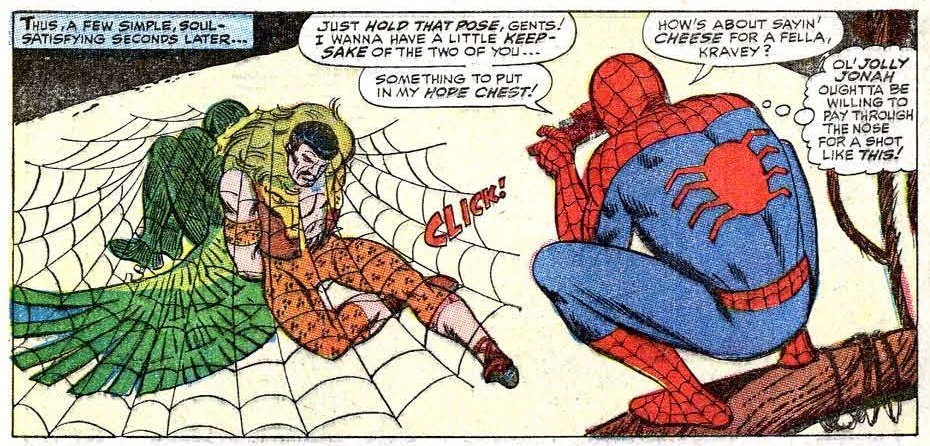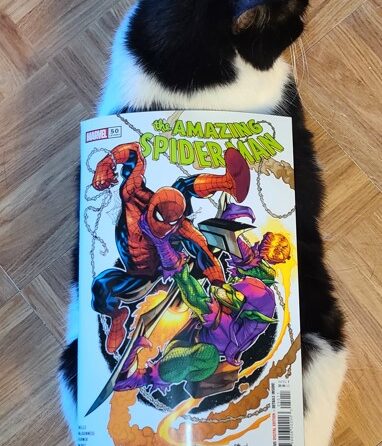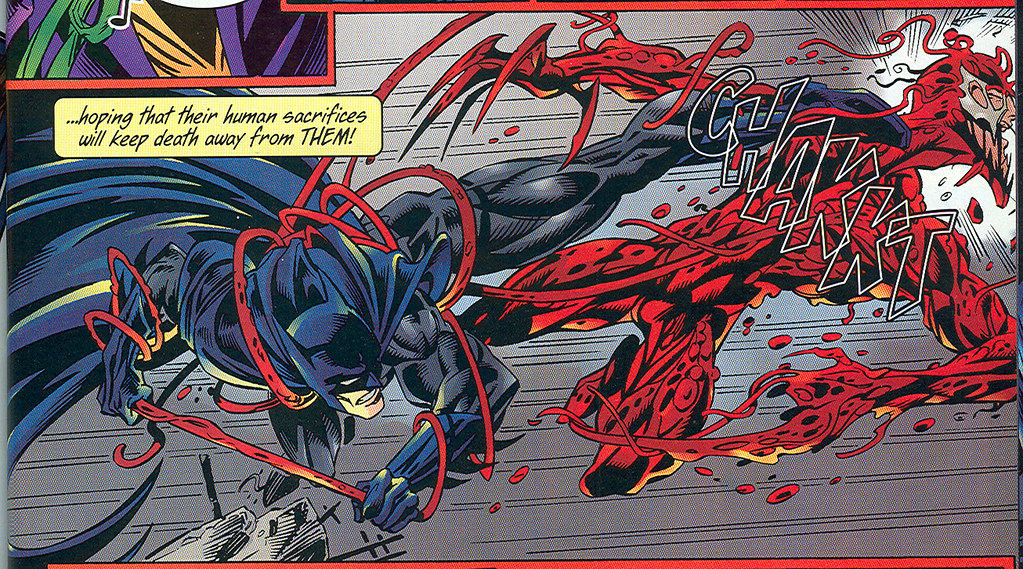Chris McKenna, one of the cowriters of Spider-Man: No Way Home, appeared on the Bulwark Goes to Hollywood podcast hosted by Sonny Bunch. The podcast largely focuses on the business of Hollywood and making movies. Bunch is an advocate of physical media and the moviegoing experience, known for some eclectic views—He has argued that the Dick Cheney biopic Vice is essentially a superhero origin story. They discussed the decision to focus on villains from previous films, some early plans involving Venom, Covid precautions when making a big-budget movie during a pandemic, and the changes they were making to the ending.
As Spider-Man fans, we’ve seen a lot of articles about No Way Home and some interviews with cast and crew, before and after they were allowed to talk about spoilers. Comicbook.com turned a Hollywood Reporter feature about McKenna and his cowriter Erik Sommers into five distinct clickbait articles, but the Bulwark interview hasn’t been covered as much online.
McKenna and Sommers have been very successful for Sony, also writing the reboot Jumanji: Welcome to the Jungle, Sony’s top non Spider-Man film. Early in the interview, McKenna was it was like to top the likes of George Lucas on lists of the highest grossing screenwriters ever, and he said he was happy to beat Sommers, thanks to his solo credit on the 2008 computer-animated horror comedy Igor.
The big question was about when they settled on the multiverse and bringing back villains from pre-MCU Spider-Man films. As McKenna says “the multiverse was the phase Marvel was going through, so it was definitely in the air. We were originally talking about… ending the movie with our movie of a Sinister Six tag, with several of the villains from earlier movies entering this world.” They had other ideas for the main film, but realized those conflicted with various Sony and Marvel film and TV projects.

McKenna talked about how they considered using Kraven the Hunter for the film. We also go to Kraven. We always ask ‘Is there a fun way to do Kraven?” This wasn’t the first time he was seen as a potential bad guy, given that he was an A-list Spider-Man foe who hadn’t appeared in any of the other movies. “There was a version of Far From Home, and it lasted for a while, where Spider-Man’s in Europe and Mysterio is the villain, and kicks Peter out into Siberia, in the cold to die, to be hunted by Kraven. It was always a fun character, and I was always like, how do we use this guy, maybe he’s not the main character but to use him in that world as a hired gun.”
He admits about that there’s some stuff that he won’t talk about, explaining “things that I should stick clear of are things that could be done in the future “as he doesn’t want to limit himself or anyone else writing a later Spider-Man movie. He compared it to how a sequence storyboarded and cut out from Raiders of the Lost Arc was later used for Indiana Jones and the Temple of Doom. He’s comfortable discussing Kraven because Sony has made it clear that they’re interested in the character by greenlighting a Kraven solo film. The announcement of that film with an actor and director attached was news to McKenna and Sommers, who had assumed they could just use the hunter at some point in the regular Spider-Man movies. They did still consider including him in the multiverse film.

When the writers were stuck on where to take the series, producer Kevin Feige suggested making the tag about the Sinister Six into the main story. As McKenna says “That was the big a-ha, which is always great when it’s Kevin, because, not kissing ass because it’s true, Kevin has the best ideas and he’s always following what would excite him as a viewer, which is why he’s so good at what he does.”
McKenna said that he and Sommers were at a Disney office when breaking the story and noted the security around to protect “state secrets” and prevent writers from wandering into the wrong room. He was usually in the Avengers meeting rooms, “reading comic books and kicking ideas around, to balance the amazing canon and the organic story we need to stay true to.”
The main consideration was how to deal with the consequences of Spider-Man being unmasked. “Does he have to go somewhere else (for) school? Does he have to go off-planet to school? You laugh, but these were explored.”
When they realized the multiversal villains story was an option, they were concerned about the logistics. It’s a unique problem when they need specific actors, rather than a new role where Sony can cast one of several names. “It’s not like what if it’s Kraven, and we shoot for the moon and it’s Tom Cruise or Brad Pitt, but can we get Alfred Molina, and Willem Defoe, and Tobey Maguire, and Andrew?” Fortunately, they got positive feedback from the actors.

Bunch asked what the shoot was like, as this was the biggest movie to be made during the peak of Covid, with much of the work before the vaccines were available. McKenna said they only needed to shut down production for just one day, which is surprising for a film with 300+ people working on it. The crew were split into pods, with McKenna and Sommers in a pod with the director and actors, because they would need to interact with them regularly . Protocols included different colored lights to indicate activities for people in different colored pods (IE- blue lights for blue pods, orange lights for orange pods.) Anyone who was feverish had to stay away from the rest, and they were tested every day.
McKenna said that writing was split into several categories: the day’s work, the week’s work, the big picture and “the alts”- alternate takes to have on hand just in case the story changes. Sometimes they need to alter things involving the second or third act, or make big production changes. One complication was when they decided to change the location of the curing of the villains to Happy Hogan’s apartment, which “was only built for some fun stuff in Act One. In the middle of shooting, we had moved everything to Happy’s apartment and it had to be reconfigured so we could tear down walls and have flames and stuff.” Initially, that sequence was supposed to happen at the school. Then they considered an auto repair shop for reasons that fit a character who they later decided it would not be in the movie, and a storage facility which would be easy to film but not as meaningful as a location that had already been established. This caused a nightmare for the production crew who did not build the condo set intending to have a giant fight sequence.
McKenna admits that “We were still trying to find the story as we were filming the movie.” He discussed how Marvel films build in times for reshoots. “Sixty percent of it is animated, (so) why not treat it like how Pixar treats their animated films, where you throw everything up, you get it all, and then we go and have to change stuff.” This is controversial, but has advantages including the material that is filmed and never used. “You get to do big swings and then realize those some of those big swings don’t work.”

March 13 was the wrap date but they knew there would be gaps. For example, they didn’t have all the scenes they wanted with Benedict Cumberbatch, so they were ready to shoot new scenes with him on the set of the Doctor Strange sequel.
McKenna said that a big chunk of the storytelling process was determining what the ‘goobers’ do. That’s a term MCU writers use for the devices like Tony Stark’s fabricating machine that can help move the plot along. “That was an ongoing conversation, to the point where (it’s like) one of those war campaigns. I remember writing a document for two days where it’s like this is what the spell does. This is what the box does. This is my pitch of what we should have them do so they’re not doing too many things, because that would be overwhelming and confusing.”
There were quite a few reshoots when it came to the end of the film. They predicted some of the stuff fans would complain about, considering a sequence where pictures and video of Peter disappear, like in Back to the Future, but figured that “getting into the nitty gritty” of that wasn’t the right emotional beat.

McKenna had recommended Kevin Goetz’s book Audience-ology: How Moviegoers Shape the Films We Love Hardcover, which includes blurbs from Producer Amy Pascal and Tom Rothman, chairman of Sony Pictures Motion Picture Group, so it’s definitely important to Sony’s approach to Spider-Man films. McKenna suggests test screenings are helpful, and says that they did three to four for “friends and family (and) people within the Disney family.” This helped determine whether audiences could understand it, because they were worried “the film may be so overstuffed that audiences can’t follow the story.” This helped refine what they needed to address. There was a lot of affection for the film among even the earliest viewers, although a few questions about what it means when people don’t remember Peter.
He suggests that the ability to add new scenes is more satisfying than using voiceovers to address plot points. McKenna compares digital photography and the ability to change scenes that were already shot to editing and proofreading a script. As he describes it, “the train leaves the station, and we’re just trying to put the track down in front of it.”

The donut shop scene was a later addition, as originally Peter didn’t make any promise to go and find MJ and Ned. Pascal recommended the scene of “Peter running into his love but his love not recognizing him, and making the choice in that moment of not telling her was born from realizing that (otherwise) he’s just spying on them and nothing’s happening.” It fit the theme of the film, as “he (has) a false hope that he can get everything he wants, just like in the beginning of the movie.”
One of the last scenes they filmed was a new version of the cemetery scene, which was originally supposed to occur before the donut shop scene. “It served two purposes, it was a little bit like a coda to show (Peter’s) head now and where he’s living his life, but it also gave some lip service in terms of what do people remember who knew him before.” It demonstrates that he’s carrying the torch forward for May, while also showing that Happy remembers Spider-Man.
A sense from the interview is that there are a lot of tradeoffs with making these blockbuster movies. If they provide too much exposition, it slows the narrative. When something isn’t explained, fans complain. If they’re too rigid, they won’t be able to adjust the film to address audience concerns, but if they’re too loose, the film will be unfocused. Things on the cutting room floor may always reappear in sequels.










Interesting interpretation.
I conversely thought the character could have been the owner or a worker of the shop. The Tinkerer and the Prowler (Miles’s uncle) from the first movie come to mind.
Auto repair shop tells me it was supposed to be Rhino as he would not fit in an apartment.
Great piece! Very interesting!
It was a much needed read, especially regarding a couple of plot points or scenes I didn’t like much.
[Spoilers]
So it’s Feige’s fault I felt a hiccup in the progression of the movie: it felt almost as they wanted to get rid of the identity’s reveal consequences as soon as possible so to use it as a springboard for the multiverse theme.
Also, now we know Happy’s apartment wasn’t the first choice for the location. If only they made a further step to justify May’s presence there… They just needed a quick exchange scene between her and Peter, where the latter doesn’t want to involve her because of the danger, but she insists since she wants to help people. Voilà, just 2 more minutes of footage and many questions solved.
I wonder who was the guy tied with the repair shop intended to be…
“We were still trying to find the story as we were filming the movie.”
And sadly it shows.